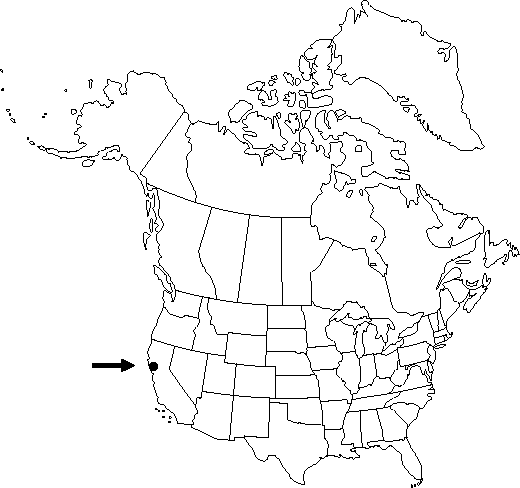Difference between revisions of "Delphinium bakeri"
Bull. Torrey Bot. Club 69: 144. 1942.
FNA>Volume Importer |
imported>Volume Importer |
||
| (7 intermediate revisions by 2 users not shown) | |||
| Line 24: | Line 24: | ||
}}<!-- | }}<!-- | ||
| − | --><span class="statement" id="st- | + | --><span class="statement" id="st-undefined" data-properties=""><b>Stems </b>(45-)60-85(-100) cm; base reddish, glabrous. <b>Leaves</b> usually all cauline at anthesis; basal leaves 0-2 at anthesis; cauline leaves 3-8 at anthesis; petiole 0.4-18 cm. <b>Leaf</b> blade pentagonal to round, 1-6 × 1.5-8 cm, margins crenate, glabrous; ultimate lobes 3-5, width 2-5 mm (basal), 5-30 mm (cauline), widest at middle or in proximal 1/2. <b>Inflorescences</b> 8-23-flowered, at least 2 times longer than wide; pedicel 1-6(-9) cm, glandular-puberulent; bracteoles 4-6 mm from flowers, green to blue, lance-linear, 5-8(-13) mm, glabrous to glandular-puberulent. <b>Flowers</b>: sepals dark bluish purple, nearly glabrous, lateral sepals spreading, 9-11 × 4-5 mm, spur apex decurved, ± horizontal, 9-13 mm; lower petal blades ± covering stamens, 5-7 mm, clefts 2-3 mm; hairs sparse, mostly near base of cleft, centered or on inner lobes, white. <b>Fruits</b> 18-20 mm, 3.5-4 times longer than wide, glabrous. <b>Seeds</b> unwinged; seed coats smooth.</span><!-- |
-->{{Treatment/Body | -->{{Treatment/Body | ||
| Line 32: | Line 32: | ||
|distribution=Calif. | |distribution=Calif. | ||
|discussion=<p>Of conservation concern.</p><!-- | |discussion=<p>Of conservation concern.</p><!-- | ||
| − | --><p>Delphinium bakeri is possibly extinct in the wild because of cultivation and sheep grazing in the small area where it grows. It is known from only two localities and has not been collected since 1960. Plants have been grown at Strybing Arboretum, Golden Gate Park, San Francisco. Although their geographic ranges are distinct, D. bakeri is most similar to, and probably closely related to, D. trolliifolium. The former has more rounded incisions on the leaves than the latter, and the pedicel of D. bakeri are consistently glandular. Glandular pedicel appear only occasionally in D. trolliifolium.</p> | + | --><p><i>Delphinium bakeri</i> is possibly extinct in the wild because of cultivation and sheep grazing in the small area where it grows. It is known from only two localities and has not been collected since 1960. Plants have been grown at Strybing Arboretum, Golden Gate Park, San Francisco. Although their geographic ranges are distinct, <i>D. bakeri</i> is most similar to, and probably closely related to, <i>D. trolliifolium</i>. The former has more rounded incisions on the leaves than the latter, and the pedicel of <i>D. bakeri</i> are consistently glandular. Glandular pedicel appear only occasionally in <i>D. trolliifolium</i>.</p> |
|tables= | |tables= | ||
|references= | |references= | ||
| Line 41: | Line 41: | ||
-->{{#Taxon: | -->{{#Taxon: | ||
name=Delphinium bakeri | name=Delphinium bakeri | ||
| − | |||
|authority=Ewan | |authority=Ewan | ||
|rank=species | |rank=species | ||
| Line 56: | Line 55: | ||
|publication year=1942 | |publication year=1942 | ||
|special status=Conservation concern;Endemic | |special status=Conservation concern;Endemic | ||
| − | |source xml=https:// | + | |source xml=https://bitbucket.org/aafc-mbb/fna-data-curation/src/2e0870ddd59836b60bcf96646a41e87ea5a5943a/coarse_grained_fna_xml/V3/V3_1014.xml |
|genus=Delphinium | |genus=Delphinium | ||
|section=Delphinium sect. Diedropetala | |section=Delphinium sect. Diedropetala | ||
|subsection=Delphinium subsect. Grumosa | |subsection=Delphinium subsect. Grumosa | ||
|species=Delphinium bakeri | |species=Delphinium bakeri | ||
| − | |||
| − | |||
| − | |||
| − | |||
| − | |||
| − | |||
| − | |||
| − | |||
| − | |||
| − | |||
| − | |||
| − | |||
| − | |||
| − | |||
| − | |||
| − | |||
| − | |||
| − | |||
| − | |||
| − | |||
| − | |||
| − | |||
| − | |||
| − | |||
| − | |||
| − | |||
| − | |||
| − | |||
| − | |||
| − | |||
| − | |||
| − | |||
| − | |||
| − | |||
| − | |||
| − | |||
| − | |||
| − | |||
| − | |||
| − | |||
| − | |||
| − | |||
| − | |||
| − | |||
}}<!-- | }}<!-- | ||
-->[[Category:Treatment]][[Category:Delphinium subsect. Grumosa]] | -->[[Category:Treatment]][[Category:Delphinium subsect. Grumosa]] | ||
Latest revision as of 22:45, 5 November 2020
Stems (45-)60-85(-100) cm; base reddish, glabrous. Leaves usually all cauline at anthesis; basal leaves 0-2 at anthesis; cauline leaves 3-8 at anthesis; petiole 0.4-18 cm. Leaf blade pentagonal to round, 1-6 × 1.5-8 cm, margins crenate, glabrous; ultimate lobes 3-5, width 2-5 mm (basal), 5-30 mm (cauline), widest at middle or in proximal 1/2. Inflorescences 8-23-flowered, at least 2 times longer than wide; pedicel 1-6(-9) cm, glandular-puberulent; bracteoles 4-6 mm from flowers, green to blue, lance-linear, 5-8(-13) mm, glabrous to glandular-puberulent. Flowers: sepals dark bluish purple, nearly glabrous, lateral sepals spreading, 9-11 × 4-5 mm, spur apex decurved, ± horizontal, 9-13 mm; lower petal blades ± covering stamens, 5-7 mm, clefts 2-3 mm; hairs sparse, mostly near base of cleft, centered or on inner lobes, white. Fruits 18-20 mm, 3.5-4 times longer than wide, glabrous. Seeds unwinged; seed coats smooth.
Phenology: Flowering spring.
Habitat: Brushlands and coastal chaparral
Elevation: 100-300 m
Discussion
Of conservation concern.
Delphinium bakeri is possibly extinct in the wild because of cultivation and sheep grazing in the small area where it grows. It is known from only two localities and has not been collected since 1960. Plants have been grown at Strybing Arboretum, Golden Gate Park, San Francisco. Although their geographic ranges are distinct, D. bakeri is most similar to, and probably closely related to, D. trolliifolium. The former has more rounded incisions on the leaves than the latter, and the pedicel of D. bakeri are consistently glandular. Glandular pedicel appear only occasionally in D. trolliifolium.
Selected References
None.
